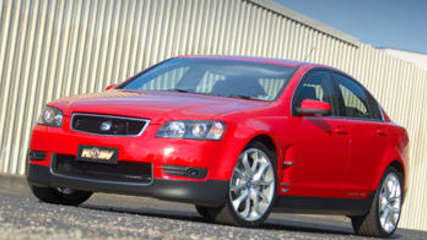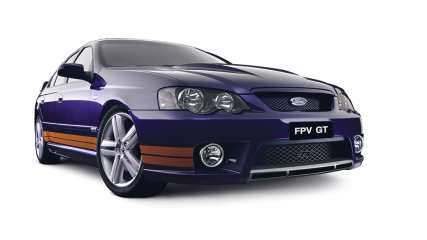HSV Senator 2011 Review
By Stuart Martin · 11 Apr 2011
Something like "$85,000 is well below the going rate for a senator's signature, isn't it?" is too easy, inaccurate (in sentiment as well as market rate, we hope). The fully-loaded Senator sits $5000 below the more-tastily named Grange long-wheelbase flagship and is less overt than the slightly more-powerful (and $1000 more expensive) GTS, but still oozes musclebound presence.VALUEThe HSV Senator Signature asks for $83,990, which in the world of prestige motoring buys you an Audi A4, C-Class Benz or 3-Series Beemer - all cars that have nowhere near the rear seat room or the brain-bending performance of the V8 musclecar.The Senator has more features than a Canberra DVD store - projector headlights and driving lights (xenons saved for the Grange), daytime LED running lights and rear tailights, leather trim, a leather-wrapped HSV sports steering wheel with height and reach adjust.The helm also has controls for the Enhanced Driver Interface and the HSV derivation of the iQ infotainment system. There's also a trip computer (with some numbers you may not want to see), Bluetooth phone link, satnav, dual-zone climate control, alloy pedals, a trio of centre-mounted gauges, the (optional at $1990) blind spot warning system, a rear overhead DVD player, HSV "performance" electrically-adjustable leather seats and an (optional $1990) sunroof.TECHNOLOGYHSV went down the path of boosting brain-power instead of horsepower for the E3 upgrade - after all, anything over 300kW and 500Nm is an "elegant sufficiency" of outputs for most road performances.The brand uses the touchscreen for more than satnav, phone and sound system functions - the Enhanced Driver Interface offers the Senator Signature driver access to a whole world of techno-babble - G-force readings, power and torque gauges and mapping and timing functions for racetracks in the system. It can also be downloaded for social media bragging rights via a USB port in the glovebox, although that feature would seem more likely to be a boy-racer's bag than that which would appeal to someone buying an $80,000 car, even one like this.Also in the same basket is the three-stage stability control, which has a competition mode for a little mis-behaving before the electronics step in. The Senator gets a more comfortable "Premium" tune of the Magnetic Ride Control, which takes the sting from the big sedan's ride (which is OK given that it's riding on the optional 20in rims) to some extent, but its on the noisy side when being asked to work hard on rutted roads.There's also the option - for $2290 - of the bi-modal exhaust - which allows the V8 to burble at the lights but speak with a more civilised tone when cruising - it's nice not to have any drone that can intrude on performance exhausts, but open up the taps and it brays with conviction.The Senator has a blind spot warning system, which flashes little red lights at the bottom of the A-pillars when a car is lurking - probably getting an eyeful of the car's powerful haunches - in the large-ish blindspot behind the C-pillar.DESIGNSubtle isn't the first adjective ascribed to any HSV product but the business suit versions sans massive rear spoiler look less "fully sick" and more corporate - in a V8 Supercar exec sort of way.HSV calls it the luxury body design with "Shockwave" exhaust outlets and the lower-key rear lip spoiler, but when it rumbles up into the rearvision mirror with its LED day time running lights gleaming too brightly for most, you'll certainly notice it.SAFETYThe Senator gets the full complement of safety features - dual front and side airbags for driver and front passenger, full-length side curtain airbags, stability control, anti-lock brakes with electronic brakeforce distribution and brake assist. The brakes are big and deal with the portly kerb-weight well - thanks no doubt to being ventilated and grooved, with four-piston calipers front and rear.The front seat belts also have with load limiters and pyrotechnic pre-tensioners. The safety features list also includes tyre pressure monitoring, rain sensing wipers and automatic headlights, front and rear parking sensors, a rear camera.It was in this area where the Senator let itself down a little - the centre display threw up an Auto Brake fault and then a Stability Control fault, which was rectified with a new brake switch component; the rear camera and satnav displays also decided to go AWOL, requiring the car to be turned off, locked, unlocked and re-started - an automotive re-boot?DRIVINGLiving up to your looks is a good thing when you look like this car - aggressive but without looking like a steroid-infused security man, perhaps more akin to that bloke's boss.The burble gives way to a mechanical bellow that's accompanied by considerable forward thrust, interrupted by auto changes that could perhaps be a little smarter and slicker.There's nothing wrong with the way it corners, defying its considerable kerb weight to track faithfully, although the tricky dampers can get a bit of a rattle up when dealing with some sharper bumps, but in the main it deals well with road imperfections, especially given its the low profile rubber wrapped around the optional 20in wheels fitted to the test car.As a roadtrip car it eats curvy country-road distances - only extreme throttle provocation makes the back wheels twitch.The Bluetooth system works well in some scenarios, although if you've plugged an iPhone into the system and then have the musicplayer going in conjunction with a phone call, the music track be heard as well - make sure you're not listening to The 12th Man first.One thing that was absent on the features list that should be there when shelling out this amount of money - there's no automatic-dimming rearvision mirror, which is something that should be in an $85,000 vehicle.VERDICTPut the badge snobbery aside and there's not much near this for the money that can carry as many passengers and luggage for a road trip - and outpunch serious sportscars if and when required. Unless you look at the FPV or Chrysler opposition, you have to triple the pricetag and buy German to get the same performance.HSV Senator E3Price: $83,990Warranty: 3 years, 100,000kmResale: 80%Service Interval: 12 months/15,000kmEconomy: 13.7 l/100km, on test 15.7; 324g/km CO2, tank 73 litresSafety: Equipment six airbags, stability control, ABS.Crash rating: 5 starEngine: 317kW/550Nm 6.2-litre OHV 90-deg V8Transmission: six speed auto, rear-wheel drive with LSDBody: 5-door, 5 seatsDimensions: 4943mm (L); 1899mm (W); 1467mm (H); 2915mm (WB)Weight: 1792kgTyre size: 19in alloy wheels, optional 20in for $2500Spare tyre: inflator/repair kit






